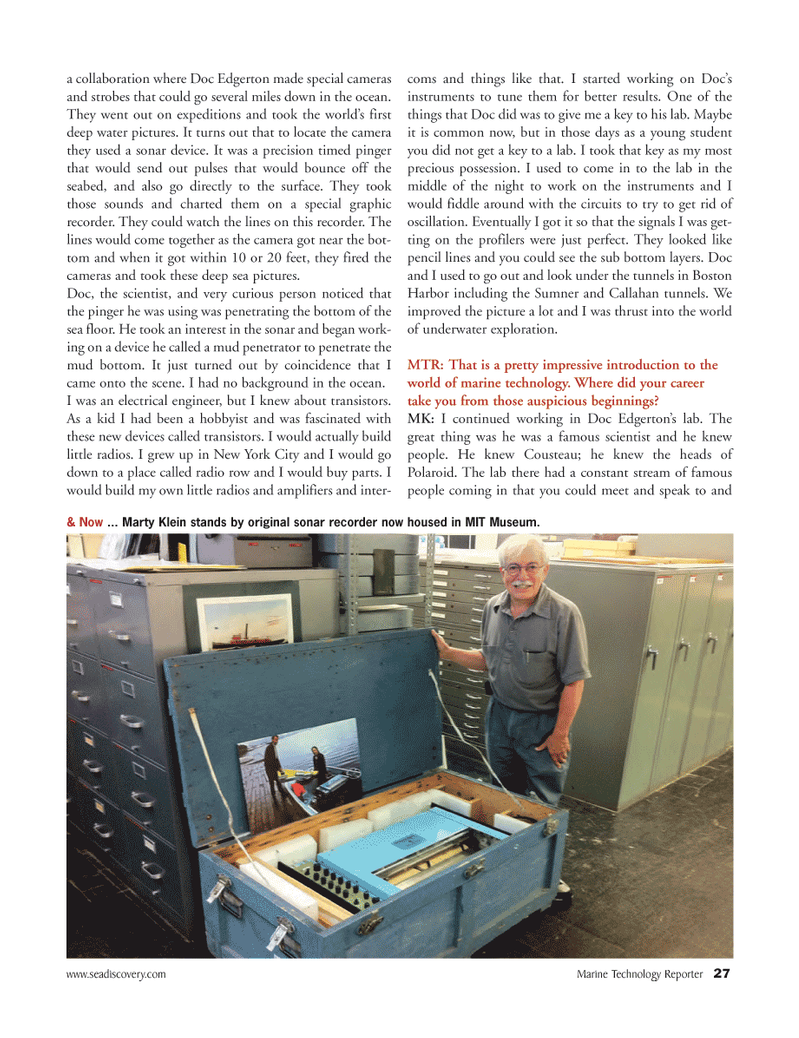
Page 27: of Marine Technology Magazine (November 2011)
FreshWater Monitoring and Sensors
Read this page in Pdf, Flash or Html5 edition of November 2011 Marine Technology Magazine
www.seadiscovery.com Marine Technology Reporter 27a collaboration where Doc Edgerton made special cameras and strobes that could go several miles down in the ocean. They went out on expeditions and took the world?s first deep water pictures. It turns out that to locate the camera they used a sonar device. It was a precision timed pinger that would send out pulses that would bounce off theseabed, and also go directly to the surface. They took those sounds and charted them on a special graphic recorder. They could watch the lines on this recorder. The lines would come together as the camera got near the bot-tom and when it got within 10 or 20 feet, they fired the cameras and took these deep sea pictures. Doc, the scientist, and very curious person noticed that the pinger he was using was penetrating the bottom of thesea floor. He took an interest in the sonar and began work- ing on a device he called a mud penetrator to penetrate themud bottom. It just turned out by coincidence that I came onto the scene. I had no background in the ocean. I was an electrical engineer, but I knew about transistors. As a kid I had been a hobbyist and was fascinated with these new devices called transistors. I would actually build little radios. I grew up in New York City and I would go down to a place called radio row and I would buy parts. I would build my own little radios and amplifiers and inter- coms and things like that. I started working on Doc?s instruments to tune them for better results. One of the things that Doc did was to give me a key to his lab. Maybe it is common now, but in those days as a young student you did not get a key to a lab. I took that key as my most precious possession. I used to come in to the lab in the middle of the night to work on the instruments and I would fiddle around with the circuits to try to get rid of oscillation. Eventually I got it so that the signals I was get- ting on the profilers were just perfect. They looked like pencil lines and you could see the sub bottom layers. Doc and I used to go out and look under the tunnels in BostonHarbor including the Sumner and Callahan tunnels. We improved the picture a lot and I was thrust into the world of underwater exploration. MTR: That is a pretty impressive introduction to the world of marine technology. Where did your career take you from those auspicious beginnings? MK: I continued working in Doc Edgerton?s lab. The great thing was he was a famous scientist and he knew people. He knew Cousteau; he knew the heads of Polaroid. The lab there had a constant stream of famous people coming in that you could meet and speak to and & Now... Marty Klein stands by original sonar recorder now housed in MIT Museum. MTR#9 (18-33):MTR Layouts 11/28/2011 9:50 AM Page 27

 26
26

 28
28
